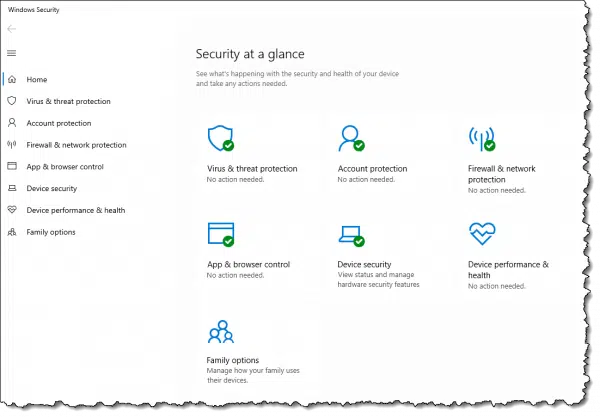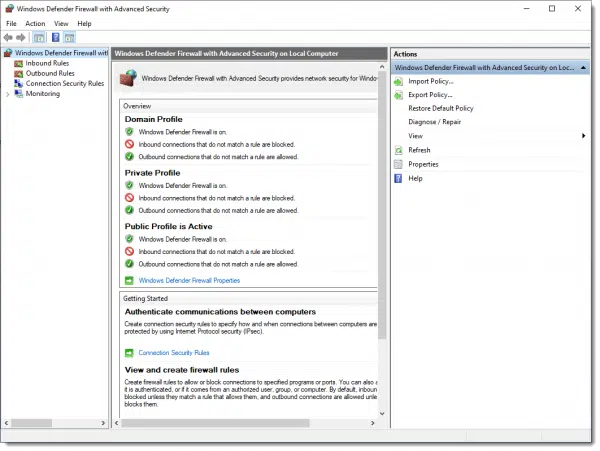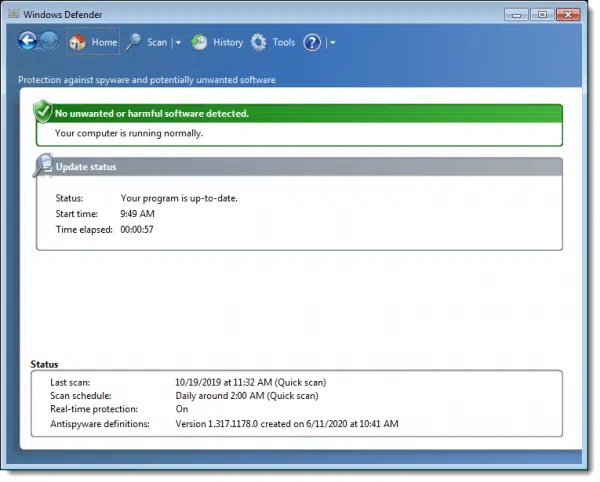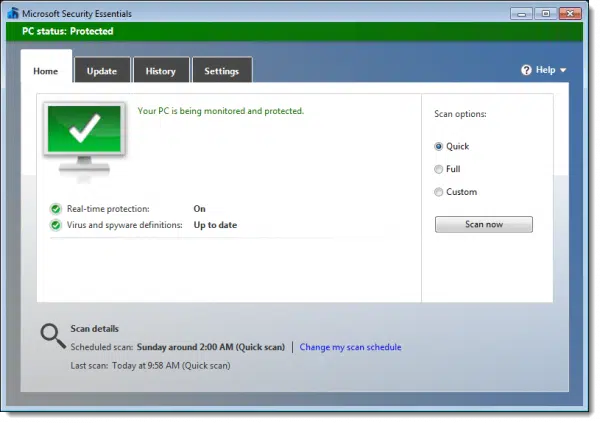Evolution.
Microsoft’s product naming frustrates me to no end. They seem to have an incredible knack for picking the most confusing names possible and then changing them.
While the names Windows Security, Windows Defender, and Microsoft Security Essentials all seem innocuous enough, what they mean has changed over time. Sometimes they mean the same thing, and sometimes they don’t.

Security vs. Defender vs. Essentials
- Windows Security is all-in-one security software included in current versions of Windows 10.
- Windows Defender is Windows Security in Windows 8. It was also the name of an anti-spyware-only utility prior to Windows 8.
- Security Essentials was all-in-one security software for Windows 7 and earlier.
Windows Security
In current versions of Windows 10, all security-related items are contained in the “Windows Security” app.

You can run this app by clicking the Start menu and typing “Windows Security”. You can also access it via the “Update & Security” section of the Settings app.
Windows Security includes anti-malware scanners and tools, tools to secure your Microsoft account, firewall and network-related protection, and much more.
It’s a one-stop location for all your Windows 10 security needs.
Windows Defender #1
What was once called “Windows Defender” in Windows 10 (and Windows 8) is now “Windows Security”.
Windows Defender was the security software included in Windows 10 for several years. It didn’t include everything currently in Windows Security, focusing mostly on anti-malware related tools. The Windows Security app collects all the security tools in one place, and in a sense, Windows Defender is just one of them.
If you click Start and start typing “Windows Defender”, one of the search results will be Windows Security.

One of the other search results, however, will not be.
Windows Defender #2
As you can see from the search results above, the first item is “Windows Defender Firewall”. Click that, and you’ll bring up the full Windows Defender Firewall interface.

My belief is that this represents a portion of the software that hasn’t yet transitioned to the new-name interface. One clue is that you can also get to this via the “Advanced Settings” in the Windows Security app’s network settings.
Yes, it’s confusing, but I think it will eventually coalesce under the “Windows Security” name.
Sadly, we’re not done with confusion just yet.
Help keep it going by becoming a Patron.
Windows Defender #3
This is where things get weird.
In Windows 7, a tool called “Windows Defender” was only an anti-spyware tool.

With Windows 7, you needed to install an additional anti-virus tool. Microsoft Security Essentials, which I’ll talk about in a moment, was a common solution. Because this additional tool also included an anti-spyware tool, it replaced Windows Defender.
The resulting security solution would be Microsoft Security Essentials with no Windows Defender.
But we’re not done with the Windows Defender name.
Windows Defender Offline
Windows Defender Offline was a version you could burn to a CD or install to a USB thumb drive. You would then boot from it and run Windows Defender without having to run the copy of Windows installed on your machine.
Booting from something other than your hard drive bypassed any malware possibly present on your machine. The result was Windows Defender Offline could do a more complete job of cleaning things up.
Windows Defender Offline was originally called Microsoft Standalone System Sweeper.
In current versions of Windows 10, the offline scanner is preinstalled and is called Microsoft Defender Offline. I don’t know why “Microsoft” and not “Windows”, except perhaps to differentiate it from the previous downloadable equivalent.
Microsoft Security Essentials
Finally, we come to the easy one: “Microsoft Security Essentials” has been relatively unambiguous over its lifetime.

Microsoft Security Essentials (MSE) was an all-in-one anti-virus and anti-spyware program. It integrated well with Windows XP, Windows Vista, and Windows 7 and remains1 a free download from Microsoft.
If that sounds familiar, it’s because that’s exactly what Windows Defender is today for Windows 10.
Do this
Subscribe to Confident Computing! Less frustration and more confidence, solutions, answers, and tips in your inbox every week.
I'll see you there!
Podcast audio
Footnotes & References
1: As of the most recent update to this article. Its malware database also appears to be updating regularly.


There may be some additional confusion as to what the asker is referring to, courtesy of Microsoft. About a year ago (or more) Microsoft released a Beta tool called Microsoft Standalone System Sweeper. People just called it “Microsoft Sweeper”. A few months later it was renamed Windows Defender Offline Beta. Either name, the tool was/is a free, standalone, bootable malware and virus remover. Neither MSSS nor the renamed WDO have anything to do with either MSE or the old antispyware that was called Windows Defender. I think 🙁
http://windows.microsoft.com/en-US/windows/what-is-windows-defender-offline
Hey, Leo, you should explain the situation for win 8 where defender is actually security essentials.
I always believed that Windows before 8 did not come with Antivirus, because I thought it would violate some sort of antitrust laws. I would think that the Mcafees and Nortons would sue Microsoft, like they got sued over bundling Internet explorer with Windows 95. When I bought this thing Windows defender was already turned off, so the free trial of Norton could be run. After that, I am using the free trial of Trend Micro, that Best Buy gave me on CD. When that one runs out in 83 days, I will uninstall it and turn on windows Defender/MSE for Windows 8. I am just used to MSE/Windows Defender. The interface looks alike. The last time I bought Antivirus was around 2002, and ten avira free came out, followed by MSE.
Dude,,,you should have mentioned the History of this Anti-malware…..
It is basically Microsoft AntiSpyware then Windows Defender, then it became Microsoft OneCare then Windows Live OneCare then Microsoft Security Essentials then it reverted back to it’s original name which is Windows Defender,,,but then they are all entirely the same engine…..just updated.
I may not be the brightest bulb in the pack! The reason I say that is, I’ve been using windows since 1998. Way back when they had dial up. 🙂 I learned early on that all the anti virus, and anti malware, slows my old computers to “almost a standstill”. So seeing how I consider myself a nobody on the internet, I don’t secure any site I may be on, for the simple reason! I never buy anything online. All my computers run super fast. True I have upgraded over the years, but I still use the least amount of security I can implement. P.S. I never been hacked.
I found MSE not able to handle malware such as WhiteSmoke, Conduit, Datamngr, and DomaIQ and many of the Fake FBI (ransomware). No one protection program has all the answers but just lately I was able to fix all of the above with RKill, Malwarebytes Anti-Malware, and to get the difficult web links and back connections I found Hitman Pro Kickstart (30 Day trial) to finish it off. A cool trick is to insert RKill into your Start Up folder and reboot. Give it about 2-3 minutes and you can get around without the FBI screen locking this up.
My Windows 7 64 bit OS came with Defender installed. Is this unusual? I thought Defender was only installed on Windows 8.
Currently I have Defender turned off, and MSE installed from the Microsoft website.
I saw the same thing on a new Win 7 machine I got today, but it was Miscrsoft Security Essential installed, not Defender. Same program, different name. It must be that they included it in an update.
It’s complicated. Microsoft, in their infinite wisdom, has changed names of tools along the way. What you’ve done is correct for Windows 7.
I used to just use Microsoft Security Essentials, because it was free, and would automatically install itself whenever I reformatted my machine. It served the purpose (but never actually caught anything). I decided to pay for Spybot (Anti-Virus and Anti-Spyware) this last time I cleaned everything up, and for some reason, MSE was NOT installed, but a program called Microsoft Defender showed up instead. Every week, it updates itself through Windows Update (it’s the only program that does, since I refuse to use Windows 10 lol). I’ve never actually “run it” to see what happens though…
I use, and like, Windows Security but I have a few questions.
1-How do you get rid of the history of objects found during a scan, once you get rid of the object on the PC?
2-How do I control what PUA are Not PUA ?
Hey, Leo, great stuff…uhhh…I seem to have both(!) Windows Defender AND
MSE running. At the same time, though I read (somewhere) that MSE would
disable WD. Ahem, no. Tweaking the registry will do the trick
sign me…confuseled.
What version of Windows? If you track all the different ways the names have been used in the article, perhaps you have the OLD Defender (spyware only) and an old MSE. If you’re on Windows 10, of course, MSE shouldn’t even install.